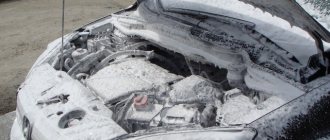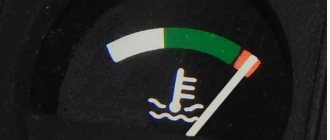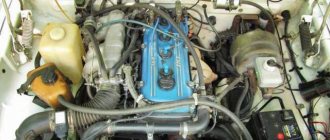Reasons why the cylinder does not work
What causes a cylinder to stop functioning? What does the phrase “cylinder not working” mean? It is known that in the internal combustion engine of a car there are cylinders where combustion of the combustible composition takes place. In this process, work is done when gases expanding during combustion push the piston down, turning the crankshaft.
If all 4 cylinders are operational, then the rotation of the car engine will be smooth, which can be immediately felt on the tachometer device, and this can be easily audible. And if a flammable composition does not ignite in a particular cylinder or work is not done to lower the piston, this will indicate that the engine is tripping. In this situation, the economizer arrow will begin to twitch, and the engine speed will lose stability.
The car is shaking, what should I do?
At the first stage, the machine is diagnosed. Let's say that you have a Niva with a carburetor engine in your garage. Your car already shows signs of “illness” at the first stage of movement. Or the car started moving without any hassle, but when a certain number of revolutions was reached, the engine malfunctioned. All this will not give answers, but only creates questions, because anything can break. In any case, if unstable operation of the car’s power unit is noticed while pressing the accelerator pedal, the first thing you should do is:
- Check air and fuel filters. The supply of air and fuel to form a combustible mixture will be difficult if these elements are heavily contaminated.
- Check the fuel pump. Its incorrect operation leads to unstable fuel supply.
- Check fuel pressure. The supply of the fuel-air mixture under insufficient pressure often leads to jerking of the car. The pressure when the engine is running should not exceed 3 kgf/cm2.
Most of the reasons lie in the car's fuel system.
Reason No. 1 – no spark is supplied to the cylinder:
- Irregularities in the spark plug. It may make its way onto the body or its gap may be set incorrectly. To control the correct operation of the spark plug, you need to unscrew it and lean it against any metal part. After that, by turning the starter, we determine by eye whether sparks appear on the spark plug. It is taken with pliers; Rubber gloves should be worn on hands. Anyone who has been hit by a 20 kV shock will fully agree that safety is absolutely necessary. Remember that although there is a spark jumping on an unscrewed spark plug, this is not a 100% indicator of its correct operation. After all, the cylinder has a completely different environment.
- Wire breakdown. If it breaks through, the spark will become extremely insignificant or disappear completely. I mentioned safety due to the fact that in my case, the factor that caused the carburetor in the VAZ 2109 to malfunction and the engine to not pull was precisely the breakdown. I began to move the wire with the engine running and took it with my unprotected hands. When receiving an electric shock, a person is unable to release the wire on his own. It was lucky that an acquaintance was nearby. Be carefull!
- There is a problem with the car's ignition distributor. For example, a contact burned out or mechanical wear occurred. This can lead to the fact that a spark from the distributor stops going to a specific cylinder.
- Hall Sensor. If it is not fully operational, it is capable of transmitting pulses from the drum on the car distributor shaft and not sending them to the switching device. That is, sparks will be missed.
Problems in the power system
The power system is another component due to which the engine can “triple”. The reason for the malfunction of the power plant due to this system is a severe depletion and over-enrichment of the air-fuel mixture - either insufficient or excessive amounts of fuel enter the cylinder. But in carburetor and injection engines, a violation of mixture formation occurs due to various malfunctions.
In a carburetor system, the fuel supply is centralized (the air-fuel mixture leaving the carburetor is independently distributed among the cylinders in the manifold). Because of this feature, the likelihood of an insufficient amount of fuel entering the cylinder is eliminated, unless rings are stuck in one of them or the valves are burned.
But incorrect carburetor adjustment causes interruptions in the operation of all cylinders at the same time (a very rich mixture floods the spark plugs, while a poor mixture will not provide a normal energy output during combustion).
On a VAZ-2109 with a carburetor, a problem often arises when “triple” occurs due to interruptions in the 3rd cylinder. This is due to air leaks in the pipe that leads to the vacuum brake booster. The fitting of this pipe is located on the manifold near the 3rd cylinder and air leakage leads to a severe leanness of the mixture entering this cylinder. When looking for the cause of the problem, be sure to check this pipe.
In the injection VAZ-2109, the power supply system is distributed, and for each cylinder a portion of fuel is supplied by a separate nozzle. In such engines, “triple” may occur due to a malfunction of one of the injectors.
As a result of a breakdown or severe clogging, the injector will overflow fuel or, conversely, supply an insufficient amount of it. Flushing or replacing the injector solves the problem with engine stalling.
Finally, we note that often the reasons that the engine is “damaged” are easily discovered during a sequential search, but their elimination depends on the characteristics of the breakdown.
Source
Reason No. 3 - compression does not occur in the cylinder:
- The piston burned out. If this happens, then during the compression stroke no pressure is produced in the cylinder, and the flammable composition flies into the crankcase. Through the ventilation system, gases are sent for afterburning into the car's air filter.
- Burnt out compression rings. Identical, the pressure disappears through broken rings.
- The intake and exhaust valves are burnt out.
- Incorrect valve adjustment.
- Hardening of valve stem seals. Such a cap does not allow the valves to completely close the cylinder intake and exhaust ports.
- The cylinder head gasket had blown and pressure began to enter the cooling system. Usually in this situation there is an explosion of a barrel of antifreeze or the presence of antifreeze in the oil.
If you are unable to identify a non-functioning cylinder, follow these steps. Wear rubber gloves. Using the choke, set the idle speed of the car engine to 1500 rpm. And unplug the wire from all cylinders one by one. Watch how the carburetor of the VAZ 2109 troits when cold. Did it start shaking, choking, stalling? Therefore, the cylinder is normal and operational. Reconnect this wire and disconnect the other cylinder. If the functioning of the motor does not change when the wire is thrown away, then the cylinder is not working.
Finally, it is possible to determine whether the reason lay in the lack of sparking or in something else. Let's unscrew the spark plug, hold it in pliers, bring it to the ground, and turn the electric starter. If a strong spark appears on the spark plug, then look for the answer among reasons 2 and 3.
It is important to understand that if it is tripping due to air leaks, then removing the wires will not help, and it is impossible to identify the inoperative cylinder. The cause of the problem in such a situation will be a depleted combustible composition.
If you still have questions regarding the question of why the VAZ 2109 engine with a carburetor fails, I recommend watching this video:
Troubles VAZ engine injector
The most capricious model regarding tripping is installed on the VAZ 2109/99. But also on newer modifications such as 2110, 2112 and 2115, similar incidents occur. Due to the presence of design differences between the engines, the further description will follow a schematic principle.
Spark plugs and high voltage wires
Before all subsequent manipulations, it is necessary to check the functionality of the spark plugs. A damaged element may not produce a spark with the required power. This is the reason for the refusal. Checking and repairs are performed as follows:
- Use a special key to unscrew one spark plug from its seat;
- Visually assess the condition of the element. There should be no carbon deposits or clouding on the working part, the electrode should be intact;
- Place the body of the part against the engine cover;
- Turn on the ignition and crank the starter. If the spark plug is working, a powerful spark should be produced when the engine is cranked.
The procedure must be performed for all four cylinders. The damaged part is replaced with a new one. Note! There is an easier way to check. With the engine running, you need to remove the spark plug cap. In this case, if the element is working properly, the power plant will begin to stall. If there are problems, the internal combustion engine will not respond.
If replacing the spark plug does not produce results (no spark appears), you need to test the armor wires:
- A multimeter is connected to the cable. The device readings should be ± 5 ohms. If the deviation from the standard is more than 10%, the part is changed;
- The second method of verification (handicraft). In place of the suspicious wire, an element from the adjacent cylinder is installed and manipulations with the spark plugs are repeated.
Compression
Compression failure can also be a decisive factor in the loss of engine power or failure of one of the cylinders. The check is performed in the following sequence:
- Unscrew the spark plugs;
- Connect the compression meter to the socket;
- Crank the starter for 1-2 seconds until the maximum indicator is displayed on the device;
- Carry out the operation for all 4 pistons.
The standard for compression of VAZ engines is 11-12 Atm. In this case, a difference in indicators of more than 10% is unacceptable. If there is strong dissonance (one of the 4 boilers shows 7-8, while the others show 11-12), urgent engine repair is required. To more accurately determine the “root” of the breakdown, you can add 5 ml of engine oil to the combustion chamber and measure the pressure again. If the device information has changed, the cause of the breakdown is sunken rings or ellipse of the cylinder. In the case of similar data, adjustment or replacement of the valves is required.
Electronic sensors
The next possible reason for a VAZ 2107 and others like it to fail is the failure of one or more sensors located on the engine. The units themselves cannot be repaired and, if they fail, must be completely replaced.
The mass air flow sensor is responsible for the correct dosage of air masses supplied to the power plant. If it does not work properly, tripping, jerking when moving, or an unstable set of revolutions is possible.
The crankshaft position sensor also affects a similar problem. From the readings of this device, the on-board computer determines at what moment it is required to fire a spark and pour a portion of fuel into the combustion chamber. If the part does not work correctly, flooding of spark plugs, tripling or even doubling of the power plant may occur.
The phase distribution sensor is installed only on cars with 16 cells, if the injection VAZ has 8 valves, you don’t have to look here. The on-board computer reads information from the sensor and determines when and how much gasoline to inject into the manifold. In fact, the device duplicates the operation of the DPKV.
This block relates to engine control equipment. The faulty part can only be determined using computer diagnostics. It is here that information is collected from all sensors, and the composition and amount of the air-fuel mixture is determined. Air supply system Additionally, it would not be superfluous to check the integrity and serviceability of the air line. If the filters are clogged, the cylinders may not have enough air, which is an indirect cause of tripping.
Injectors
The main root of evil is often the pressure nozzles, which are responsible for supplying fuel directly into the combustion chamber. In 90% of cases, the cause lies in blockages. Low-quality gasoline may contain small mechanical impurities or water. In the first case, a speck may get through the filters and clog the thin opening of the part. The second option is oxidation of the walls of the gas tank with the subsequent spread of rust. The consequence is that the clogged hole does not allow gasoline into the engine in the required quantity. For diagnostics, the injectors are dismantled and their condition is checked. Broken or deformed elements are replaced with new ones.
Factors affecting detonation
There may be many reasons for the appearance, but they have one thing in common - the delay in spontaneous combustion of the air-fuel mixture (unburned portion) removed from the electrodes of the spark plug is reduced. To put it simply, all the conditions appear in the combustion chambers for oxidative processes to occur. The occurrence of detonation is affected by:
- Qualitative composition of the combustible mixture. If the air/gasoline ratio = 0.9, then the fuel mixture, when it enters the combustion chambers, forms pockets in various places. It is in them that oxidative reactions begin to occur, and they subsequently ignite.
- The increased ignition timing leads to the fact that the maximum pressure during combustion of the mixture is observed at the moment when the piston is almost at top dead center. As a result, the pressure increases and detonation occurs.
- Too low octane number of gasoline affects the appearance of characteristic knocking sounds. If you refuel with AI-92 gasoline, then when AI-80 enters the tank, the operation of the engine will change, and significantly. To avoid such problems, you need to buy fuel at trusted gas stations. Or option 2 - installing an octane corrector.
- The higher the compression ratio, the higher the octane number the gasoline should have.











